Two For The Road: Traveling Route 66
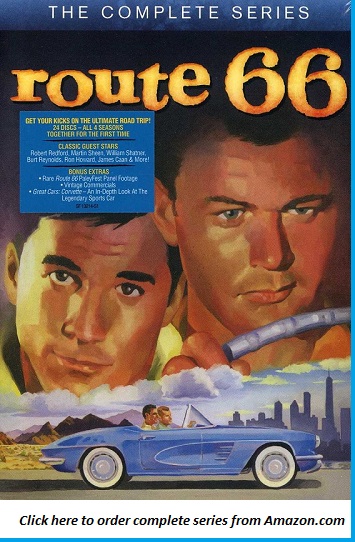
This article appeared in a slightly different form in "Mad About Movies Magazine" No. 9 (November, 2014). Thanks to Mad About Movies for letting us share it here!
This bittersweet recollection began as a succession of comments and observations found at the on-line "Classic Horror Film Board" TV forum where, to my amazement, the usual fantasy themed discussions had turned miraculously to an affectionate remembrance of the 1960's CBS Television series Route 66 starring Martin Milner and George Maharis.
While I remain a lifelong fantasy/science fiction/horror buff, I continue to have a fertile region of my heart reserved for this iconic buddy series about a pair of traveling friends who sewed their youthful oats along the legendary highways of what came to be known as Route 66.
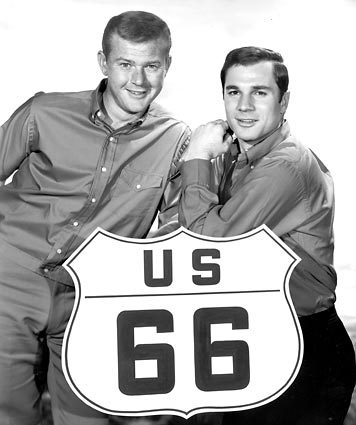
My love sonnet of personal reflection began with often pain filled memories lost, seemingly, to cultural antiquity and emotional transition. I have to tell you that, while I obviously adored the genre programs so often spoken of in these discussions, Route 66 has always been, and will always be, my all-time favorite TV series.
My brother Erwin and I were lonely, messed up kids struggling to find our voice and identities when we first began watching Route 66 in 1960 on CBS. Right from the very first episode, "Black November," we knew that we were in for something different. This opening salvo seemed, to us, shot out of a cannon. It was powerful, shocking, and really quite scary. Here were these two young men traveling in the middle section of the country, stranded in what seemed another planet, stalked...threatened...and attacked by vicious backwoods Neanderthals right out of Bad Day At Black Rock.
Alone, and at the mercy of these bullies and thugs, Tod Stiles and Buz Murdock fought to preserve their inherent decency while fighting off the attacks of an insane mob mentality. We were hooked right from the beginning. This was television like we'd rarely, if ever, seen it before.
Route 66 appeared on series television at the tail end of a distinguished cycle of live telecast dramas, and owed much to the excitement and intensity of the decade that had preceded it. While the series was broadcast each week on film, its location shooting gave it a sense of momentous reality found nowhere else on the tube. The program had a semi-documentary sensibility and was, in many ways, the dramatic, if fictional, forerunner of many of today's most riveting reality programs. The show had a sense of both immediacy and urgency about it, and it was difficult at times to remember that it was, after all, a scripted series.
My brother and I had led relatively sheltered lives of youthful sensitivity, idealism, and romantic desperation. This became our escape, if you will. It was our secret ticket to adventure, a passport shared by only the two of us in the comparative safety and passenger seats of our home living room vehicles. Erwin and I, in a sense, became Tod and Buz...traveling the country vicariously in front of our television sets and sharing their exhilarating rite of passage. We grew up on the road, floating over the tires of a testosterone laden Chevy Corvette.
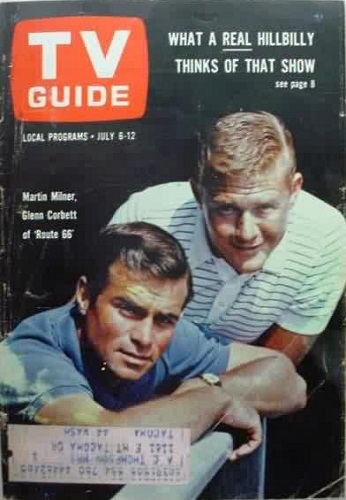
While we'd known Martin Milner from films and television over the years, we'd never seen or heard of George Maharis. He was for his time, perhaps, the most exciting new talent to emerge from the shadows. His was a raw, unbridled talent that seemed too large for the small screen. He was an exciting new presence...volatile...uncontrollable...and explosive. He came seemingly out of nowhere, and yet possessed much of the same Actor's Studio energy shared by Marlon Brando, James Dean, Frank Sinatra and other post war actors finding meaning in their inner rage and torment. Maharis had appeared in some small roles in major films, most notably as a Jewish freedom fighter distrustful of Paul Newman's intentions in Otto Preminger's Exodus in 1960.
For his part, Milner had always played squeaky clean boys next door in a succession of American films dating back to Life with Father. In the late fifties he'd begun taking on more edgier adult roles in such cutting edge films as The Sweet Smell of Success, and Marjorie Morningstar.
The stories and issues populating the scripts of this adventurous series were often provocative, emotionally powerful and, on a purely instinctual level, deeply and profoundly poetic. Produced by Herbert B. Leonard, with scripts by Stirling Silliphant, and original music by Nelson Riddle, Route 66 grew more fascinating with every moment of growth and passage of miles. While Leonard's own Naked City airing on ABC contained much of the same idealism and growing pains as its fledgling younger sibling, the locations for the popular cop show were largely grounded inherently in and around New York City.
Stiles and Murdock, however, were under no such geographical constraints. They were like brothers, sharing life's adventure on the road, and finding maturity in their travels, free to move in whichever directions their whims and desires led them.
The inspiration for the series reputedly came from a lunchtime conversation between Leonard and Silliphant in which Leonard recounted his early years as a penniless teenager hanging around with his best friend who just happened to be wealthy. From that thread of a recollection came the birth of Tod Stiles, a rich kid whose father died, leaving him only a Corvette with which to survive, and Buz Murdock, his street wise buddy, tempting him to search out new experiences on the road again.
The list of actors and actresses who populated their journey read like a casting call of every aspiring star or veteran performer alive and working. Many of America's finest young dramatic actors and actresses learned and developed their craft while appearing on the road exploring "Route 66." These included Robert Redford, Robert Duvall, Martin Sheen, Edward Asner, and James Caan.
We lived for each new experience on life's unfolding highway. Each new city, town, and neighborhood across the United States provided Tod and Buz with physical and emotional challenges designed to test both their endurance and yearning early maturity. However, the moment of ultimate truth came for us in the Summer of 1961 as the pair neared the Eastern Coast of the United States, and it was announced that they would travel first to Baltimore...and then...to Philadelphia to shoot two episodes on location. We were exhilarated to learn that our literary counterparts would be travelling to their psychic home town to play out our fantasy dual existence.
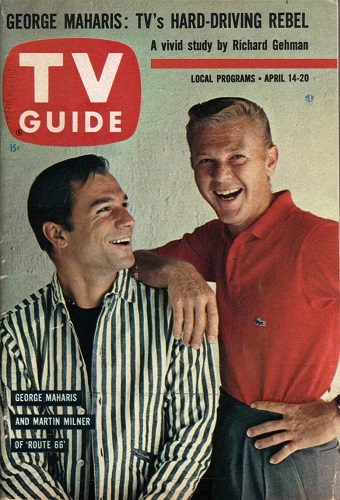
In mid-October, 1961, Tod and Buz drove into the outskirts of Philadelphia. Our frustration turned achingly real when we learned that the brother of our next door neighbor was the head of the local advertising company playing host to the cast and crew. Ed and Rose Sommers had been our neighbors for many years. Their kids had grown up alongside of us. Ed's brother Allan Sommers, was the unit publicist for the show while they were in town. It seemed only natural that Ed would arrange for us to meet our heroes by interceding on our behalf with his brother.
Reality reared its ugly head when what appeared natural and fitting to us was looked upon merely as intrusive by Ed and Allan. We might just as well have been any old "generic" fans hoping for a momentary glimpse of their idols. This would be a once in a lifetime experience and opportunity for us. We had to take matters into our own sweaty palms and plan a secondary course of action. We learned through the local newspapers that the cast was being housed at a popular motel just behind the city limits. So Erwin and I cut school, and took a bus to the Marriott Motor Hotel on City Line Avenue in Bala Cynwyd, just outside of Philadelphia. Our excitement grew quite palpable as we saw the many production trailers sitting conspicuously in the hotel parking lot.
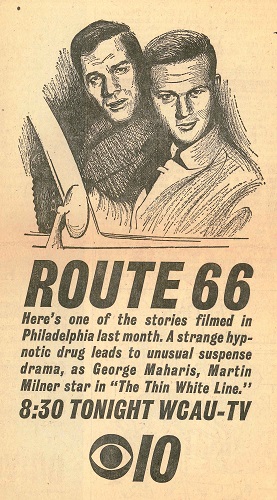
Walking into the lobby of the hotel (I was fourteen years old...Erwin three years younger), I noticed character actor Murray Hamilton sitting on a couch reading a newspaper. He was playing a doctor in the episode they were filming. We walked over to him and introduced ourselves. I doubt that anyone else in the lobby had any idea who he was. I think he was so taken by these two kids who knew who he was that he invited us to sit down and talk with him. He was very kind, as I recall, and spent fully a half hour chatting with us about his career, working with Jimmy Stewart in both The FBI Story and The Spirit Of St. Louis, and working on The Twilight Zone opposite Ed Wynn. (He later played "The Mayor of Shark City" in Steven Spielberg's Jaws.
We walked out of the lobby and into the parking lot, adjoining the Marriott restaurant and there, eating his breakfast all alone through the glass window, sat Martin Milner...brooding and intense, it seemed to us. He was deep in thought, lost in his character, and looked up to face us. We had evidently pulled him from the dark recess of an emotionally exhausting thought process back to seemingly mundane reality. Feeling intrusive, we backed away from the window and came back into the hotel lobby.
There we saw George Maharis emerging from the elevator. We approached him and told him how much we loved the series. He was warm, outgoing and very friendly to us. We talked for a few moments, and he invited us to join him and the rest of the crew for the climactic "shoot" in downtown Philadelphia at the Ben Franklin Bridge. His enthusiasm for the day’s schedule was infectious. We didn't have to be asked twice.
We took yet another bus back into the inner city and found the immense structure dangling imposingly over the skyline of our cherished city. Somewhat apprehensively, we climbed onto the walkway of the massive expanse until we reached its suspended epicenter. On the opposite walkway the technicians and cast of Route 66 stood preparing to film the final dramatic moments of what would prove to be our favorite, most intensely personal episode of the entire series. Martin Milner, in later interviews, said that it was also his favorite episode of the show.
Per the story, Tod had mistakenly swallowed a "mickey" intended for someone else. We watched as Tod, in drug induced paranoia, threatened to jump from the bridge to his death in the raging traffic below. "Don't do it, buddy. I love you," cried Buz to his stricken friend. As Tod regains his senses, climbing precariously into the sheltering arms of his beloved friend and brother, the scene ended, and the camera crew began disassembling their equipment.
The ensemble began coming down from the bridge, and Erwin and I came down with them, meeting at the opening gateway to the skies. As George Maharis walked quickly down to the street, he saw us standing there and waved enthusiastically with his characteristic smile. It was a moment we would somehow never forget.
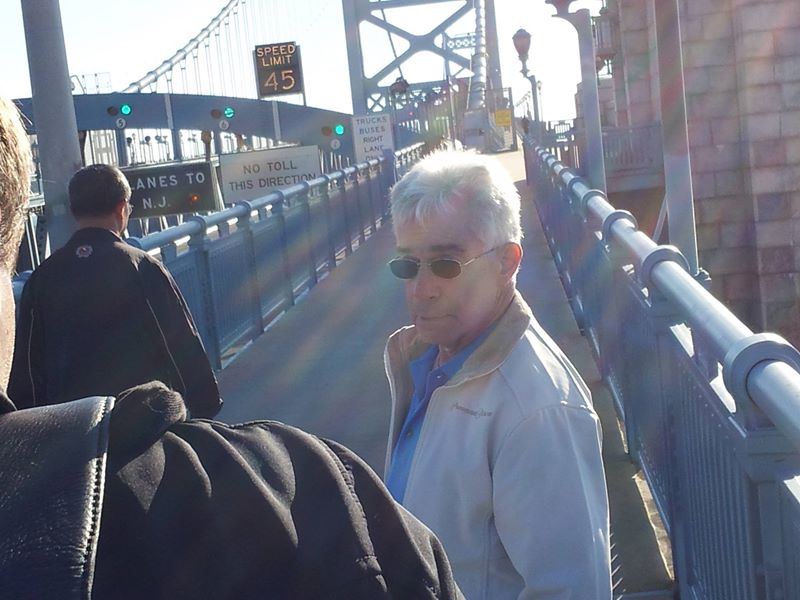
Returning to the site of the climactic sequence from "The Thin White Line"
on The Ben Franklin Bridge in Philadelphia, more than half a century later, for the
filming of "The Man Who "Saved" The Movies" documentary.
"The Thin White Line" aired over the CBS network during the second season of the show on December 8th, 1961. That hour would become the program's crowning achievement. It was all about love, friendship and loyalty...a recurring theme on the series, but never more passionately captured on film than in this magnificent episode. (As for George Maharis, his own personal favorite episode of the long running series was a story called "Even Stones Have Eyes" in which he is temporarily blinded after a construction accident. Sobbing, sightless, through the dispassionate reflection of a hospital window, he cries..."I want to see.")
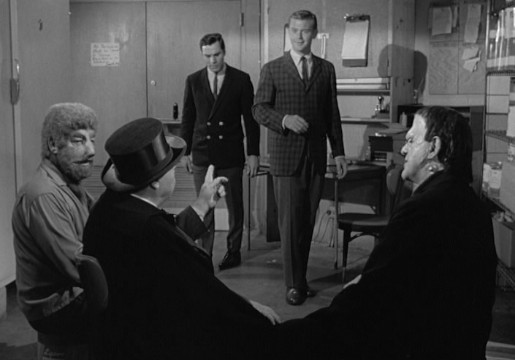
Genre fans throughout the world rejoiced one memorable evening in late October, 1962, as the series presented its joyous comedic salute to the world of monsters and madmen at Halloween. "Lizard's Leg and Owlet's Wing" was a delicious bit of fluff in which three of monsterdom's most ghoulish practitioners arrived at a mid-western hotel incognito to discuss ways and means of returning the horror film to its former illustrious resonance. Boris Karloff appeared in one last, incomparable moment as Frankenstein's "Monster." Lon Chaney, Jr. appeared as his most enduring incarnation, "The Wolf Man," while Peter Lorre laid humorous waste to his own most monstrous creation, appearing as...well...Peter Lorre.
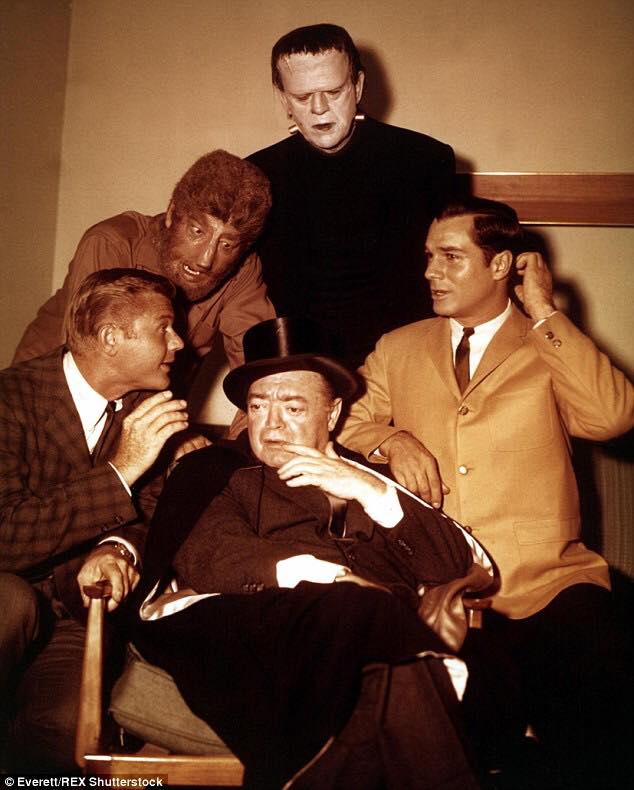
As delightful as this memorable thematic detour from the famous highway may have been, the series found its most significant and enduring voice in its unflinching dramatic writing and performances, offering unforgettable treatments of such sensitive topics as mental illness, drug addiction, and racial inharmony. Route 66 became a beacon of searingly honest, often painful dissections of social injustice, and of the human condition.
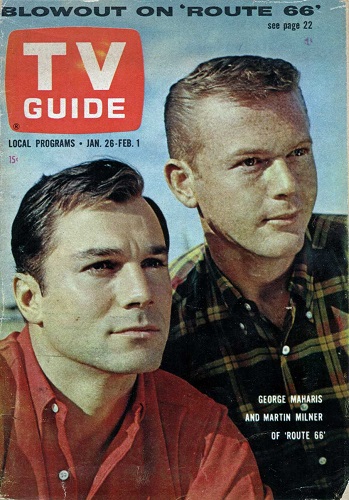
Fantasy is a poor substitute for reality, however. As powerful as was their on screen relationship and chemistry, something had gone terribly wrong behind the cameras. Maharis was growing restless, and wanted to move on. Milner said in later interviews that he was shocked to learn that his co-star didn't like him. Whether that was perception or factual, Milner would later comment in an interview with TV Guide, "I thought the guy liked me."
Obviously stung by gossip of a growing resentment on the part of his co-star, Milner became hurt and reclusive. On the set of "Even Stones Have Eyes,"Maharis was called upon to jump into an icy stream in order to rescue actress Barbara Barrie. He caught a chill, and ultimately grew sick with a case of Hepatitis, subsequently missing a succession of episodes of the series due to confinement and hospitalization. He would use this sickness; it was later said, to remain off the set for numerous episodes at a time.
Maharis denied these published accusations as ridiculous and false. Milner filmed episodes by himself, while the network did its best to put a hopeful spin on the situation. The producers changed the thrust of the series to reflect a mysterious hospitalization, while the writers scrambled to compose stories in which Tod would telephone his friend from various cities along the fabled route, vainly awaiting his return to their joint excursions.
For a time, Maharis did return and the series appeared to be getting back on track. Herbert Leonard seemed unsympathetic to the actor's health issues, bowing to contractual pressure from CBS to fulfill completion of their scheduled slate of programs. When Maharis continued to miss episodes, he was eventually replaced by Glen Corbett...but the magic was gone. Corbett was a decent actor who struggled vainly to fill the shoes of his predecessor, but simply couldn't duplicate the raw charisma and magnetism of Maharis. The show continued uninspired for a time, and finally left the CBS schedule after four years.
However, those first two and a half years were among the finest hours of dramatic series' writing and performance in the troubled history of television...and, for one brief, shining moment...we were there.
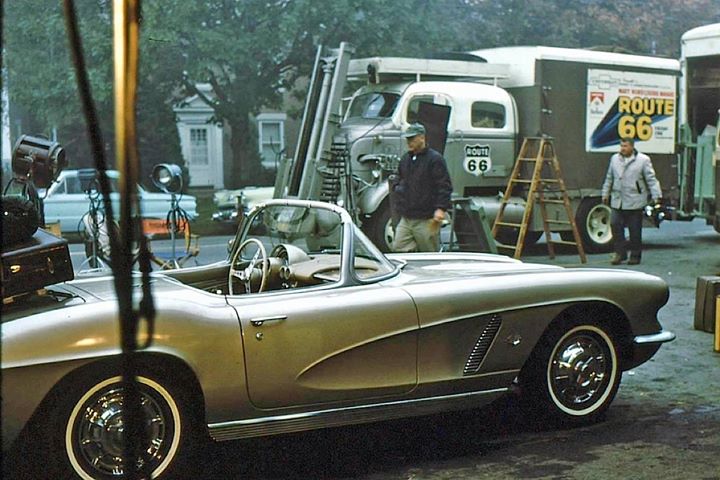
THE CAR
Should memory serve me, for this occurred nearly six decades ago, the car was only taken out of the van when it was going to be photographed for a pertinent shot. When not in use, it was generally hidden from prying eyes inside one of the massive transport, tractor trailer trucks that accompanied the company around the country. I may have observed the back of the corvette sitting inside the truck, but I hope you won't ask me about its color. It's just too long ago.
Incidentally, there's a fascinating blog by writer Karen Funk Blocher about the series at Route 66 News on line. It's actually a very depressing account of the rapid rise and fall of George Maharis, and the circumstances leading to his eventual career decline.
It isn't a secret at this late date that the actor was gay. Herbert B Leonard, the show's executive producer, hired Maharis because he felt that the up and coming star would be a tremendous babe magnet for the series, drawing women viewers to CBS and driving ratings through the proverbial roof. Supposedly, he was angered by what he perceived as a deliberate deception by Maharis, growing openly antagonistic towards him on the set. However, during a question and answer panel staged by The Paley Center For Media in 1990, both Leonard and Maharis sat next to one another, appearing quite cordial, and enjoying a celebration of the series that they had created.
When Maharis developed Infectious Hepatitis, and was confined to a hospital bed, Leonard assumed that it was merely a ploy by the actor to lobby for a raise in salary. For his part, Maharis had every reason to assume that when he returned to the show his work load would be lessened in deference to his recent sickness. Instead, the producer subjected him to grueling fifteen hour work days, often in sub-freezing temperatures. Leonard let it be known that he had a trouble maker, and a prima donna on his hands and he lost little time in spreading the word. He felt that the actor's sexual proclivities and continuing absences from the set had doomed his cash cow to an early demise. The producer had imagined taking the show, if not on the road…then on the sea, with the travelers crossing the ocean to explore other countries in their signature Corvette. Maharis, on the other hand, was growing genuinely concerned for the state of his health, feeling that Leonard was irreparably hurting him. The actor grew increasingly resentful of his surroundings and position, eventually leaving the series for good.
With Herbert B. Leonard spreading the word around the industry that Maharis was simply a negative influence who effectively murdered the future of his once popular series; the actor's reputation became irretrievably damaged. He found it increasingly difficult to find work. Studios were afraid of his negative reputation. He did solid work as the lead in The Satan Bug, but starring roles became as elusive as the deadly infection of the film’s title.
When Karen Blocher finally interviewed Maharis in the early eighties, he was starring in summer stock and dinner theatre. During the performance that Blocher witnessed, a particularly vitriolic elderly lady in a wheel chair was shockingly vocal about her own opinion of the actor's masculinity. It must have been a nightmare for Maharis who angrily defended his decision to leave Route 66 for legitimate health concerns.
The roles eventually dried up entirely, and Maharis appeared on television as a supporting player on such shows as Murder She Wrote for the very network on which he'd once been a star of the highest magnitude.
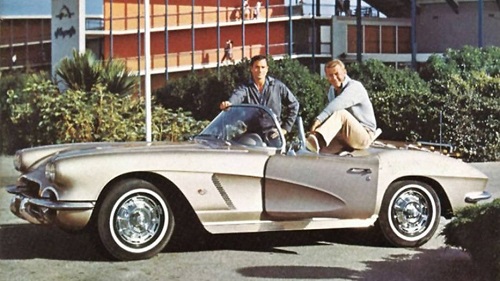
In more recent years, Maharis discovered another emerging talent as a sculptor, and has become somewhat renowned as an artist, having his work as the focal point of numerous high end shows at prestigious art galleries in and around San Francisco. For a time he also succeeded as a talented recording artist, a singer recording two albums and appearing as a guest on the weekly Judy Garland television series for CBS. Yet, his was an exciting and brilliant new talent that became tragically extinguished before its time...a star blazing in the heavens, heart-breakingly obscured by clouds of jealousy and anger. I wished, somehow, that I could find him, and tell him just how deeply and profoundly his work impacted the lives of millions of fans... particularly two brothers named Steve and Erwin whose memories of Buz Murdock and Tod Stiles continued to shape and influence their world.
Fate would intervene, however, in the early hours of 2008. I had persuaded an acquaintance with personal contact information for Maharis to give me the address of either a publicist or advertising representative of the actor located out West. I wrote a short, but passionate letter to him in which I spoke of my affection for his work, and of the profound influence that both the series and his character had had on much of my life.
Some time had passed, and I had given up any hope of hearing from George. I had been spending the last days of 2007 in San Francisco at the invitation of the legendary Castro Theater where I had programmed and co-hosted a nine day Miklos Rozsa Festival, honoring the Oscar winning composer with seventeen handpicked films. The composer's daughter, Juliet, had driven out from Los Angeles to join me on stage for an interview prior to a Saturday night screening of Ben Hur on the showcase Castro screen.
Upon my return home to Philadelphia, I found a message awaiting me on my answer machine. It was from George. The husky voice, although somewhat aged, was unmistakable. My eyes filled with tears as I listened to his words. He chuckled, mischievously I felt, as he briefly thanked me for my letter, sounding a trifle stunned, as he put it, that his performance had impacted my years and my youth so profoundly. He said that he would attempt to contact me again when I might be home. I waited for that second telephone call to come. Sadly, we were never able to connect. I've written him again each summer when I’ve traveled the skies high above Route 66 heading west and, miraculously, George has telephoned me several more times now, leaving delightful messages laced with warmth and humor. I continue to wait for that phone to ring again, and to hope that I might be able to speak with him personally just one more time.
ROUTE 66
One final word, perhaps, concerning my all too apparent affection for Route 66, and its stars. The year was 1960, and I was reaching the end of my thirteenth year. The stodgy Eisenhower era was thankfully drawing to a close and my eyes were beginning to open to an awesome canvas of vibrant possibilities. I was becoming a man, and the responsibilities that lay ahead both thrilled and frightened me. I began to emerge cautiously from the protected haze of childhood, sensing an increasing awareness of what my impending maturity might offer. Memories of the war had subsided, and there was an air of excitement permeating the days and weeks that soon would dawn. Everything was new. Everyone was young.
Danny Ocean was rolling the dice in Vegas, while Sinatra was re-inventing "cool." Frank, Dean and Sammy epitomized youth, and swinging, enthusiastic vitality. Their appetite for success, women, and booze was hypnotic. A young, charismatic Senator was charming the nation, and it wouldn't be long before John Fitzgerald Kennedy would ascend to political stardom and royalty as the youngest President in American history. Richard Burton was starring on Broadway as King Arthur in Lerner and Lowe's romantic fantasy, while young Jack Kennedy would eventually have his princely reign and kingdom compared idealistically to the charmed and mythical kingdom of "Camelot."
I felt an excitement that I'd never known before. I entertained a political point of view for the first time in my life, growing exhilarated at the promise of a life unfolding wondrously before my eyes. I took pride in my country, and believed in its flawless integrity. My personal identity had begun developing, emerging from my introspective cocoon, and I was intoxicated by the limitless vistas proliferating my dreams and sweet imaginings.
Tod and Buz became the wistful symbols of what the future might be holding for me as I prepared to lay the groundwork for leaving the safe, predictable confines of home and hearth...discovering success, adventure and romance on the road beneath their wheels. I was barely fourteen years old, reveling in the sweeping winds of idealism blowing joyfully across America. These brave, integrous travelers seemed to encapsulate our dreams and yearnings as we lived vicariously through their weekly adventures. Within the fabled confines of that magical Corvette, the world was young once more..and so were we. A bright and shining optimism embraced America and there was, at long last, hope and promise for the future. Route 66 signified for me the suggestion of What Dreams May Come. Nothing was impossible, and the road awaited. An endless panorama of limitless highway beckoned seductively. It was, perhaps, the most exciting period of my youthful prayers and innocence. Yet, I would never find my Shangri La. The journey ended prematurely...not only in disappointment and sadness for the young performer who had excited my imagination, but on the crowded streets of Dallas as a series of gunshots shattered the euphoria of a kingdom on November 22nd, 1963.
It all seems so long ago now....a revered and precious dream eaten away by often bitter years and tarnished experience. Where did it go? How could it have disappeared so quickly? I was an innocent, merely thirteen years old, when I first joined Tod and Buz in the "back seat" of their handsome Corvette in 1960. Youth was a gentle promise, a tantalizing voyage mysteriously emerging from the shadows of childhood.
Astonishingly, George will turn ninety years of age on September 1st, 2018. Sadly, we lost Marty to heart failure on September 6th, 2015, at age eighty three. I felt as though I had lost a dear, cherished friend. Perhaps, in truth, I had. As for me, I recently turned seventy two years old. I've undergone open heart surgery, career displacement, and divorce. And yet, in a strange way, Route 66 symbolized the short-lived hope that tugged so longingly, once upon a time, at my young dreams and romantic aspirations...and so, for the wonder of that moment, forever frozen in time, its bittersweet journey will ever occupy a deeply special place in my heart.
"Don't let it be forgot,
that once there was a spot,
for one brief shining moment,
that was known as Camelot."
Steve Vertlieb, 2018
|











